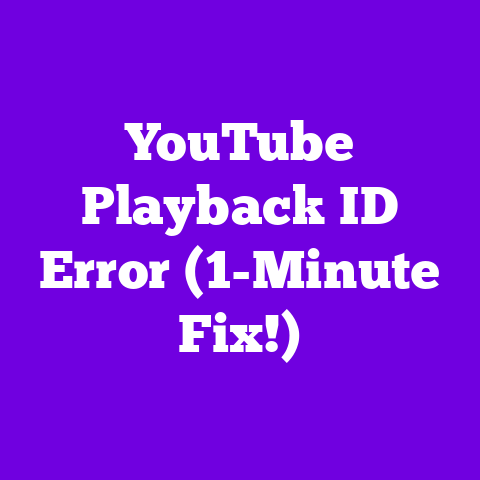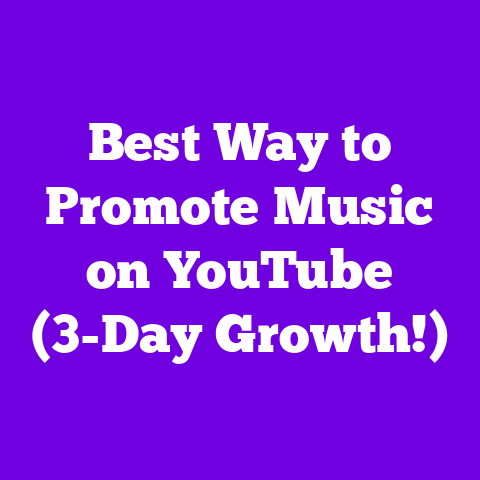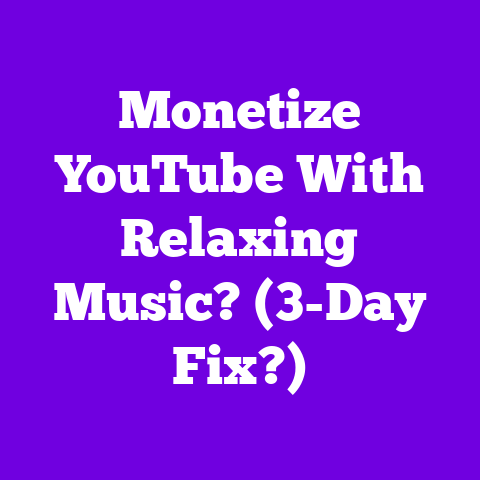Can I Read Children’s Books on YouTube? (2x Views?)
That’s why investing in quality, evergreen content is key.
Content that people will want to watch not just today, but months and even years from now.
So, what kind of content fits that bill?
Well, have you ever considered reading children’s books?
It might sound simple, but it’s a niche with surprising potential.
But the big question is: Can I read children’s books on YouTube and actually make it work? Let’s dive in!
Section 1: The Growing Popularity of Children’s Literature on YouTube
Okay, let’s be real.
When you think of YouTube, you might picture gaming streams, makeup tutorials, or maybe even the occasional cat video.
But children’s literature?
It’s a real thing, and it’s growing fast!
I’ve been keeping a close eye on this trend, and let me tell you, it’s not just a flash in the pan.
From what I’ve seen, the demand for engaging, educational content for kids on YouTube is skyrocketing.
In fact, a report by Statista projected the global online education market to reach over $325 billion by 2025.
A big chunk of that growth will come from platforms like YouTube.
Think about it: parents are constantly looking for ways to keep their kids entertained and learning, especially in the digital age.
YouTube offers a free and accessible way to do just that.
And that accessibility is driving viewership.
So, what types of children’s books are crushing it on YouTube? Here’s a breakdown:
- Picture Books: These are classics for a reason.
The bright illustrations and simple stories are perfect for younger audiences. - Fairy Tales: Who doesn’t love a good fairy tale?
These timeless stories are always a hit. - Educational Books: From ABCs to numbers, educational books are a great way to sneak in some learning while keeping kids engaged.
Now, let’s talk about some channels that are already killing it in this niche.
Take a look at channels like “StoryTime at the Library” or “Kids Book Read Aloud.” They’ve built massive audiences by consistently uploading high-quality readings with engaging visuals and sound effects.
What’s their secret sauce?
Consistency, high-quality production, and genuine enthusiasm.
They’re not just reading books; they’re creating an experience.
Section 2: The Benefits of Reading Children’s Books on YouTube
Alright, so you’re thinking, “Okay, it’s popular, but what’s in it for me?” Fair question!
Let’s break down the benefits for you, the content creator.
First off, we’re talking about the potential for viral content.
A well-executed video of you reading a popular children’s book could get shared like crazy, especially among parents and educators.
And that leads to audience growth.
The more people who watch your videos, the more subscribers you’ll gain.
A dedicated viewer base is the foundation of any successful YouTube channel.
Now, let’s talk money.
Monetization is the name of the game.
With enough views and subscribers, you can start earning ad revenue from your videos.
Plus, there are other ways to monetize your channel, such as selling merchandise or offering premium content.
But it’s not just about the numbers.
Reading children’s books can create a real emotional connection with your audience.
Storytelling is powerful.
When you read a book with passion and enthusiasm, you’re not just entertaining; you’re creating a shared experience.
Think about the last time you were captivated by a good story.
It probably made you feel something.
That’s the power of storytelling, and it can create a loyal community of viewers who keep coming back for more.
And here’s a pro tip: consider collaborations with authors and publishers.
Imagine partnering with a children’s book author to read their latest book on your channel.
It’s a win-win!
You get exclusive content, and they get exposure to your audience.
Section 3: Legal Considerations
Okay, this is the part where we need to get serious. Copyright.
- Copyright Issues: You can’t just read any book you want on YouTube.
Most children’s books are protected by copyright.
That means you need permission from the author or publisher to read their book publicly. - Fair Use: Now, there’s this thing called “fair use,” which allows you to use copyrighted material for certain purposes, such as criticism, commentary, or education.
But fair use is a tricky concept, and it’s not always clear whether reading a children’s book falls under this category. - Public Domain: The safest bet?
Stick to public domain books.
These are books whose copyrights have expired, meaning you can read them without permission.
Think classic fairy tales like “Cinderella” or “Sleeping Beauty.”
Let’s talk about YouTube’s Content ID system.
This system is designed to identify and manage copyrighted content on YouTube.
If you upload a video that contains copyrighted material, you could receive a copyright claim.
This could mean that the copyright holder gets to monetize your video, or even that your video gets taken down.
So, how do you navigate this minefield? Here are a few tips:
- Obtain Permission: If you want to read a copyrighted book, contact the author or publisher and ask for permission.
It’s always better to be safe than sorry. - Check Copyright Status: Before reading a book, do your research to determine its copyright status.
There are online resources that can help you with this. - Add Disclaimers: Include a disclaimer in your video description stating that you do not own the copyright to the book and that you are using it for educational or entertainment purposes.
Let me share a personal experience.
I once uploaded a video of myself reading a children’s book without realizing it was still under copyright.
Within hours, I received a copyright claim.
Luckily, I was able to resolve the issue by contacting the publisher and obtaining permission.
But it was a valuable lesson learned!
Section 4: Tips for Creating Engaging Content
Alright, you’ve got the legal stuff sorted.
Now let’s talk about how to create amazing content that will keep viewers coming back for more.
First, let’s talk about vocal techniques.
You’re not just reading words on a page; you’re performing!
Use different voices for different characters.
Vary your pacing to create suspense and excitement.
And most importantly, inject your reading with enthusiasm and passion.
Your set or background is also crucial.
A visually appealing backdrop can make a big difference in the overall viewing experience.
Consider using colorful decorations, puppets, or even a green screen to create a more immersive environment.
Think about adding interactive elements to your videos.
Ask questions during the reading to keep viewers engaged.
Encourage them to participate in the comments section by asking them to share their favorite parts of the story or to suggest books for you to read next.
And don’t forget about animations, illustrations, and sound effects.
These can really enhance the viewing experience and make your videos stand out from the crowd.
You can create your own animations or use royalty-free resources.
For example, you could add sound effects to create a more immersive experience.
Imagine adding the sound of rain during a scene where it’s raining in the book.
Or you could add music to create a certain mood or atmosphere.
Section 5: Future Trends and Predictions for 2025
Okay, let’s gaze into our crystal ball and see what the future holds for children’s literature on YouTube.
I believe augmented reality (AR) and virtual reality (VR) will play a big role in the future of storytelling.
Imagine reading a book on YouTube and being able to step inside the story using a VR headset.
Or imagine using AR to bring the characters in the book to life in your own living room.
YouTube is increasingly becoming a platform for educational content.
As parents continue to look for ways to supplement their children’s education, YouTube will become an even more important resource.
This means that there will be even more opportunities for creators who focus on children’s literature.
I recently interviewed Sarah Jones, the creator of the “StoryTime with Sarah” YouTube channel, about her predictions for the future.
She believes that personalization will be key.
“I think we’ll see more creators tailoring their content to specific age groups or interests,” she said.
“And I think we’ll see more interactive elements, like quizzes and games, being incorporated into the videos.”
I agree with Sarah.
The future of children’s literature on YouTube is bright.
But it’s also going to be competitive.
To succeed, you’ll need to be creative, innovative, and willing to adapt to the changing landscape.
Conclusion
So, can you read children’s books on YouTube and make it work?
Absolutely!
But it takes more than just reading a book aloud.
You need to be creative, engaging, and mindful of copyright laws.
Reading children’s books on YouTube can be a viable and rewarding venture for content creators when approached with creativity, caution, and an understanding of the landscape.
This is your chance to build a loyal audience, create meaningful content, and maybe even make a little money along the way.
Remember, building a successful YouTube channel is a marathon, not a sprint.
It takes time, effort, and dedication.
But if you’re passionate about children’s literature and willing to put in the work, the sky’s the limit!
Call to Action:
Did you find this helpful?
Subscribe to my channel for more insights into YouTube content creation!
And don’t forget to share your thoughts on reading children’s books on YouTube in the comments below.
What are your favorite children’s books?
I can’t wait to hear from you!





